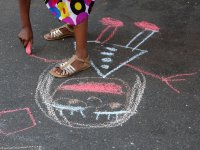Turning Summer Reading Loss Into Learning Gain
This summer, students can make their reading meaningful by thoughtfully applying what they learn to their own lives.
Your content has been saved!
Go to My Saved Content.It’s almost summer, which, depending on where on the planet you live, probably means it’s warming at least a little. Coinciding with this warming trend and a general flowering of the land is a break in our processes of formal education. School’s out. And just as summer brings fairs and vacations and skateboard tricks, it also brings sunburns and mosquitos and skinned knees—and summer learning loss and its great propagator, summer reading loss.
Most research shows that children read less in the summer. How much less depends on age, income level, geographic region, and other factors.
And how much of a bad thing you think it is for students’ achievement scores to fall because of summer break depends on your perspective, too. But let’s assume that you’re in favor of pushing academic achievement and the improved test scores that seem to reflect it. What do you need to know?
What Test Scores Reveal
First, a glance at the research. With many topics in education, there are wildly varying research findings to support an equally wide variety of interpretations and takeaways. Want to fund a 1:1 program? Somewhere there’s research to support it. Against that idea? There’s likely data somewhere that agrees with you.
But in general, the research on summer reading loss says two things:
- Summer does tend to impact academic achievement.
- What it impacts and how depends on content area, income level, age, and more.
For example, in “The Effects of Summer Vacation on Achievement Test Scores: A Narrative and Meta-Analytic Review,” researchers concluded that “the summer loss equaled about one month on a grade-level equivalent scale, or one-tenth of a standard deviation relative to spring test scores. The effect of summer break was more detrimental for math than for reading and most detrimental for math computation and spelling.”
But socioeconomic factors complicate general statements about seasonal changes on educational performance and literacy. The researchers claim that “significant difference was also found for income level on the effect of summer vacation on reading recognition scores; low-income students showed a significant loss in reading recognition over summer while middle-income students showed a significant gain.... Middle-income students gained about 2.3 months in reading recognition over summer, while lower-income students lost about 1.5 months.”
And grade level? Other studies have found that younger students (e.g., those in kindergarten) often have better scores in the fall than in the spring, while older elementary students (e.g., fourth and fifth graders) reverse that trend. “Summer setback,” then, isn’t a simple issue, complicating efforts to make simple recommendations.
Learning and Applying
In “Stopping the Summer Slide in English Language Arts,” I provided basic recommendations, from starting digital book clubs to sending home high-interest texts, and even simply staying in touch as often as possible with students through email or social media. How useful these ideas are depends on how old your students are, their relative access to technology, whether or not they’re on vacation, your amount of free time, and more.
One of the most universal patterns of learning in any context is to encounter a new idea and then put that idea into action somehow, whether through near transfer or far. A daily pattern of reading and then doing something as the result of that reading can provide an easy framework for authentic learning outside of the classroom. Reading Robert Frost? Extract a theme from “Mending Wall” and do something with it. Say hello to a neighbor. Tear down a metaphorical wall between you and an old friend or family member. Make a painting of a wall that conveys Frost’s message. Create a song that is opposite in tone but similar in theme. Create a fence to set a boundary in a relationship.
In other words, read something worth reading, think about what you’ve read, and then use that reading to inform your behavior in the real world in a way that’s authentic and useful to you. Does what you’re learning have any transferability in your life? I don’t mean transfer in the sense of applying something that you’ve learned in a new and unfamiliar context, but rather taking something that you’ve learned here and applying it there. Actually use what you’ve learned—in this case, what you’ve read. This will require you to reflect on what you’ve learned, have a sense of the utility of that knowledge, and demonstrate vision, imagination, or creativity in putting it to use.
This stands in marked contrast to the “long tail” view that traditional academics take for standard creation and curriculum design, where the value of what’s learned is low at the onset and is perceived to increase over time as students prepare to enter universities or the work force.
Place-based education. Self-directed learning. Maker education. Open-ended projects. Personal challenges. The roots of every student are in his or her community, in the families, digital networks, and favored communities. Summer is a time when students have more opportunities to be closer to these roots. Reducing summer loss might begin, then, with helping students see what they have to gain during this time away from the classroom by seeking out and using information to improve their crucially native circumstances.
